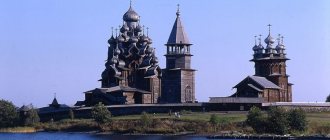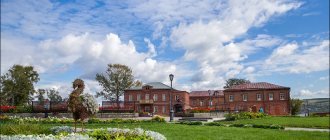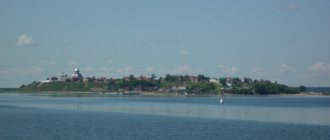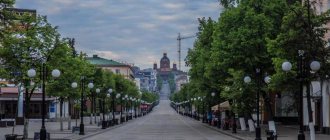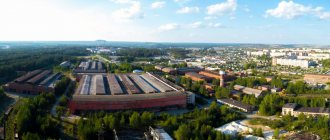The article explains:
- Basic information about Kizhi Island
- History of the island
- The main attractions of Kizhi island
- Folk crafts on Kizhi island
- Fauna and flora of the island
- Weather on Kizhi Island
- How to get to the island
- 7 interesting facts about Kizhi island
Kizhi Island is rightfully considered the hallmark of Karelia, although it is only one of almost one and a half thousand similar pieces of land spread across the northeastern part of Lake Onega.
Moreover, Kizhi is one of the most interesting sights in Russia due to the presence of unique monuments of wooden architecture. However, the nature of the island itself is also magnificent. The landscapes of the Russian North, although modest, are not without quiet charm. A strip of forest near the shores, emerald green grass in the meadows, transparent Lake Onega. And also, according to legend, Kizhi is a holy island, which at one time received the blessings of hermit elders.
General information about Kizhi
Kizhi is a small island located in the northern part of Lake Onega. Geographically, it is part of the Republic of Karelia (located in the north of the Russian Federation on the border with Finland).
Kizhi Island is located in the northern part of Lake Onega
The island is very small: its total area is only 5 km2. It is 5.5 km long, while its maximum width reaches 1.4 km. The distance from Petrozavodsk (the capital of Karelia) is 68 km.
Interestingly, the outline of the geographical object resembles a crayfish claw.
The outline of the island resembles a claw of a crayfish.
As for the population, there were once more than a dozen villages on the island. Today, two have survived - Yamka and Vasilyevo, consisting of only a few houses (they are architectural monuments). The first is located on the eastern shore of the lake, the second - on the western. About 50 people permanently live there: most of them are employees of the museum-reserve, as well as the police and fire department.
Through the pages of history
Archaeological excavations have discovered that the first settlements on Kizhi date back to the 6th–5th centuries. BC e. These were Finno-Karelian peoples. A reminder of their settlements are the names of the villages located next to the island of Kizhi: for example, Lakhta, Konda, Korba, etc.
The very name “Kizhi” is reminiscent of the Finnish “Kizhat”, translated this word means “games”. Therefore, it can be assumed that there was once a pagan temple on the island, where games with ritual sacrifices were held. However, there is another version, associated with the Karelian word “kiidzhi”. This is the name of water moss: this is exactly what grows in the center of the island in the swamp. In the old days, local residents used it to insulate wooden buildings.
The Russians came to this land already in the 10th century. These were Novgorodians who began to develop the northern region. And over the centuries, a kind of fusion of the culture of the Slavs and Finns was formed on the Karelian lands (this was reflected in the language, literature, and architecture). Local residents become Orthodox, and churches are often built on the site of pagan temples.
By the 15th century, the Moscow state was gaining power, which divided the Russian lands into several provinces with districts (they were called “pogosts”). The territory of the island of Kizhi, together with its closest neighbors, became the center of the Spaso-Kizhi churchyard: it was mentioned for the first time in surviving documents from 1563.
It is interesting that in modern Russian the word “pogost” is used only in the meaning of “church with a cemetery” and “rural cemetery”.
According to documentary data from 1582, there were 115 villages in the Kizhi Pogost, 12 of them were located directly in Kizhi. The islanders were mostly engaged in farming and fishing, but there were also woodworkers among them. In the same scribe book there is the first mention of Kizhi temples (they were burned by lightning, and new ones were later built in the same place).
In the 17th century, several copper smelters were founded in the Kizhi Pogost. However, farmers were hostile to them and did not want to work there. Then the authorities wanted to force the local residents to do this by force, but a group of villagers led by the headman staged an armed protest (it was suppressed by a sent streltsy detachment).
In the 18th century, churchyards were abolished, and Kizhi, together with neighboring lands, became part of the Kizhi volost of Petrozavodsk district (Olonets province). By the beginning of the 20th century, there were only 9 villages left here: with the beginning of industrialization, residents began to move to cities.
By the 20th century, there were 9 villages left on the island
1966 is the year of foundation of the Kizhi Museum-Reserve. It included architectural structures existing on the island, as well as buildings and outbuildings that were gradually transported from various regions of Karelia. In 1990, the Kizhi Pogost was included in the UNESCO World Heritage List, and three years later - in the State Code of Especially Valuable Objects of the Cultural Heritage of the Peoples of Russia (by decree of the President of the Russian Federation).
Chapel of Our Lady
In the village of Eglovo, at the end of the 18th century, local residents jointly erected a Chapel in the name of the icon “The Mother of God, the Joy of All Who Sorrow.” The belfry, an indispensable attribute of the chapel, was built a little later.
The building's canopy was often used for general gatherings. Tall carved windows overlooking the lake do not provide much light, which creates an atmosphere of mystery of the prayers being read. The staircase leading to the belfry is also decorated with northern ornaments. In the exhibition “Kizhi Necklace”, the chapel occupies one of the main places in terms of the beauty and clarity of the carvings.
How to get to the island
You can get to the museum-reserve from Petrozavodsk or from the village of Velikaya Guba. There are trains, buses and planes to the capital of Karelia. There is a regular bus from Petrozavodsk to Velikaya Guba (passing through the city of Medvezhyegorsk).
From May to October, communication with the island is primarily by water. From Petro and “Meteora” (covered ships): tickets for them are sold at the Water Station or on the embankment of the Karelian capital. The tourist will have to spend about an hour on the way (ships go very quickly). A more expensive option is a water taxi (in the form of small boats). In addition, ships call at Kizhi as part of the cruise. Private speed boats (for 5–10 people) also depart from the village of Velikaya Guba.
You can also use a helicopter. Regular flights (at different times of the year) operate from the airports Peski (near Petrozavodsk) and Besovets (near the village of the same name).
In winter, Lake Onega is covered with a thick layer of ice, and you can get to Kizhi by SUV from Petrozavodsk: there are companies in the capital of Karelia that offer similar trips. In addition, during the winter season, Kizhi can be reached by small hovercraft.
Photo gallery: transport links with Kizhi Island
During the navigation period, communication with the island is mainly by water
You can also get to Kizhi Island by helicopter.
In winter you can get to Kizhi on a small hovercraft
Bath
The log house of the bathhouse, brought from the village of Mizhostrov, was part of the estate of N.M. Oshevnev. His house, built in 1876, is nearby. The structure of the bathhouse, despite the lack of sewerage and electricity in those days, is absolutely comfortable.
In the corner there are stone boulders, which, when heated, saturated the room with healing steam. The stove-heater is almost invisible. A boardwalk leads from the entrance to the bathhouse to the lake. Museum workers maintain the residential appearance of the entire estate. Both in the house and in the owner’s buildings, and in the bathhouse, one gets the impression that the owners are about to come.
A unique architectural and historical open-air complex
The Kizhi Museum-Reserve is unique in that it is located in the open air. It is the largest of such objects in Russia: its area exceeds ten thousand hectares. The basis of the complex is the ensemble of the Kizhi Pogost, which consists of two churches (Preobrazhenskaya and Pokrovskaya), a hipped bell tower and a fence.
The basis of the museum complex is the ensemble of the Kizhi Pogost
Church of the Transfiguration
The most majestic building of the churchyard is the Church of the Transfiguration of the Lord. It was she who was included in the list of the most beautiful churches in the world. The original building (1714) was destroyed by lightning. The name of its creators remains unknown. In the period from 1949 to 1959. the building was recreated according to the design of A. Opolovnikov.
As an old legend says, the church was built by a carpenter named Nestor. After completing the work, he threw his ax into the waters of the lake so that no one could repeat this unearthly beauty.
The height of the temple is 37 meters. Such a large-scale structure was created practically without the use of nails (with the exception of the “scales” on the domes, fastened with small nails). Numerous onion-like domes make the appearance of the structure simply fabulous. There are 22 of them in total, and they are placed in tiers on curved roofs.
Numerous onion-shaped domes give the church a fabulous look
Although wood is a fairly complex material for constructing intricately shaped buildings, the Kizhi craftsmen were true experts in their craft. The basis for the church was pine, while individual elements of the structure were made of birch and aspen.
The Church of the Transfiguration is as magnificent inside as it is outside. For example, the iconostasis is decorated with a carved gilded frame: on it you can see graceful flowers and vines. It includes 102 icons. All of them are ancient: two were written at the end of the 17th century. (“Transfiguration”, “Pokrov”), the main part - in the second half of the 18th century, the three upper tiers - at the end of the 18th century. The ceiling is also painted: in the middle of it there is an image of the Trinity surrounded by angels and forefathers.
Iconostasis, consisting of 102 icons, all carved and gilded
The Transfiguration Church is considered a summer church: services are held only in the warm season, because there is no heating here.
Church of the Intercession of the Virgin Mary
Near the Church of the Transfiguration there is a Church of the Intercession of the Virgin Mary. It was erected half a century later - in 1764. This church is much more modest, but at the same time it organically complements the previous one.
The Intercession Church, more modest outside and inside, organically complements the Transfiguration Church
The Church of the Intercession is crowned with nine domes: eight of them surround the central one. They are all expressive and sophisticated. A serrated pediment belt decorated with carvings adds a warm note to the building. In addition to its decorative function, it also protects the walls of the temple from moisture: it prevents water from getting on them during rain.
A high single-flight porch leads visitors into the interior. The inside of the temple is as modest as the outside. The original iconostasis was lost, and a new one appeared in 1950, when the building was restored.
The interior decoration of the Intercession Church is also modest
The guides have a curious story connected with the Church of the Intercession. One day, when a group of tourists was in the temple, a thunderstorm began. The guide needed something to keep people occupied. Near the Last Judgment icon, he slowly began to talk about mortal sins (all of them are mentioned on it). After the word “drunkenness,” bright lightning flashed and thunder erupted. Thus, it was as if the guests of the island were told which sin was the most terrible.
The Church of the Intercession is winter. Services are held here from October to Easter, on weekends and church holidays.
Tent bell tower
In 1863, on the site of the old bell tower (it was dismantled), a new one 20 meters high was erected. This happened at the request of priest Stefan Romanovsky. In 1874, its upper part was rebuilt, and in 1900, the decorative pediments that surrounded the perimeter of the cornice were dismantled.
A new bell tower was erected on the site of the old one at the request of a local priest.
A staircase of five flights leads to the belfry, covered with a tent. Tourist groups are usually not allowed to go up here. Meanwhile, the views from here are simply stunning.
A magnificent panorama of the island opens from the belfry platform
Video: bell ringing of Kizhi Island
Fence
In 1959, the fence was recreated: the old one was lost over time. The model was a wooden fortification on Vodlozero (another body of water in the Republic of Karelia, once there was an Ilyinsky churchyard here). Massive log buildings, a watchtower on the corner, and an unusual, impressive gate give the building a resemblance to an ancient fortress. The perimeter of the fence is 300 meters.
The perimeter of the fortress-like fence is 300 meters
The structure has a high foundation, and there is a log frame on it, with a gable roof on top. The central entrance with double gates is located in the west near the Church of the Intercession. On the main facade there are windows that are closed with wooden shutters. There are two more gate entrances, as well as a corner turret on the north-west side. It is decorated with a carved spire.
Massive log frames of the fence are located on a high foundation of stones and covered with a gable roof
Church of the Resurrection of Lazarus
On Kizhi Island you can see a wooden building, which is one of the oldest in Russia. This is the Church of the Resurrection of Lazarus, which, according to legend, is more than six centuries old.
As the legend says, the temple was built by the Monk Lazar, who was the founder of the Murom Monastery (the monastery is located on the eastern bank of the Onega). He died in 1391, having lived to be 105 years old. The church was the first building of the monastery complex and became famous for its miraculous and healing properties. Every summer on Midsummer's Day (June 23–24), many pilgrims from different countries came here.
The construction of the Murom monastery itself was dedicated to the biblical miracle - the resurrection of Lazarus from Bethany. This was supposed to help strengthen the Orthodox faith in the almighty Jesus Christ.
In 1959, the Lazarevskaya Church was dismantled and brought to Kizhi. Over the next two years, it was restored and the vestibule was recreated. The final restoration took place in 2006: the severe distortion of the frame was eliminated (since the temple does not have a foundation, but stands on stone boulders), the roof was replaced, and a new dome appeared.
The temple itself is quite miniature with simple and graceful forms. It consists of three cages, close in shape to a square. Each cage has a separate gable roof with its own slope.
The two-tier iconostasis of the Lazarus Church is represented by 17 icons from the 16th–18th centuries.
According to legend, the Church of the Resurrection of Lazarus is more than 600 years old
Chapel of Michael the Archangel
The museum complex also contains a small chapel named after Michael the Archangel. It dates back to the beginning of the 19th century and was originally built in the village of Lelikozero (north of Lake Onega). The religious building was transported to Kizhi in 1961. This is a typical structure of northern Russian architecture with a hipped bell tower and vestibule.
The chapel was transported to the island from the village of Lelikozero
Of interest is the ancient iconostasis of the chapel, dating back to the 17th–18th centuries. It is connected to the ceiling icon of Jesus Christ, the forefathers are located around it, and in the corners you can see images of the evangelists.
By the way, during an excursion to the chapel of the Archangel Michael, guests of the island are shown various types of bell ringing (blagovest, chime).
Eight-wing windmill
Kizhi is interesting not only for its religious buildings. It will be extremely interesting for lovers of ethnography and researchers of ancient Russian life. So on the island you can see a windmill (very few of them have survived in Karelia). The utility building was built in 1928 in the village of Volkostrov, and then transported to Kizhi. The building from 1976 was restored.
The mill was built in 1928 and restored half a century later
The premises are two floors. Below there is a chest for flour and a device that regulates the grinding of grain. At the top, tourists can see stone millstones and a horizontal shaft; on the outside it ends with eight wings. Today the mill is still operational.
The mill is two-story, at the bottom there is a device that regulates grain grinding
House of Peasant Shchepin
On the island there are several old Russian huts, built in the traditions of the Russian North. All of them were brought to Kizhi from different parts of Karelia.
It is curious that the scientist I. Makovetsky, who studied Russian folk architecture, points out that it was in the North of Russia that the most advanced examples of peasant housing arose.
For example, Shchepin’s house was transported to the museum-reserve in 1975 from Volkostrov (2 km from Kizhi).
The house of the peasant Shchepin is a typical dwelling of the Transonezh peasant of the early 20th century
The construction is typical for the Transonezh peasantry of the early 20th century. This is a four-wall building covered with a gable roof. A small porch leads inside the room, with two exits. Inside the house there is a small closet where there are stone millstones and a chest for flour. However, the building does not have a utility part - a yard. In addition, the stove is located in a peculiar way - it is slightly moved away from the wall.
In the interior of the house, tourists can see items of cooperage craft (making barrels and other wooden containers).
Inside the hut you can see objects related to the craft of cooperage.
House of peasant Elizarov
Elizarov's house was transported in 1961 from the village of Potanevshchina (which is located on the neighboring Klimets Island). This is another version of the Transonezh peasant dwelling. Residential premises and utility rooms are located under a single roof. The first and only floor is located on a high basement (it is intended for grain storage). The hut has a canopy and two closets.
From the outside, the façade of the home is decorated with a decorative balcony: behind it there is an attic. An interesting image of the house is created by the contrast of impressive log walls and laconic platbands.
The main facade of the house is decorated with a decorative balcony
There are curious objects in the house. For example, opposite the stove there is a wall cabinet with a beautiful painting for storing ceremonial dishes (especially for tea parties with guests). There is a spinning wheel designed for the production of flax threads. There is a patterned warm blanket on the bed.
There are many interesting things in Elizarov's house
Near Elizarov’s house on the shore of the lake there is a bathhouse dating back to the beginning of the 20th century (it was brought from another village - Ust-Yandom). The object was added to the exhibition in 1970.
House of peasant Oshevnev
The house of the peasant Oshevnev already belongs to the wealthy (it was brought from the Karelian village of the same name, and the barn was from the village of Kokkoila). The large building has two floors and is decorated with carvings and intricate architraves (various symbols and amulets are depicted). The house is very solid - it was originally built to last.
The house of the wealthy peasant Oshevnev is large, two-story, has more decorative elements
By the way, the outstanding restorer A. Opolovnikov, who restored the house in the 50s of the 20th century, wrote the following about it in books on Russian architecture:
The house is huge: two floors with a living room, a covered courtyard, a long open gallery encircling the living area on three sides, and an elegant balcony near the living room. The word “izba” is somehow inapplicable to him, he is so big and impressive. Its volume reaches an impressive figure - two and a half thousand cubic meters!
A. Opolovnikov
https://egaristotel.livejournal.com/117670.html
The dwelling, designed for a large family, has two living rooms, as well as a room, a front room and a small room. The economic part is also located under the same roof. The furnishings inside are very simple, but many things are again decorated: a towel with embroidery, a spinning wheel with intricate paintings. There are no luxury items or decorative trinkets here (although, obviously, the owners could afford them).
Things inside the house are useful, durable and beautiful
Video: Kizhi - the wooden miracle of Russia (Soyuz TV channel)
Church of the Mother of God Intercession
The service in the temple took place from October (Protection) until spring (until Easter). The church, cut down in 1694, is crowned with a crown of 9 domes. The Church of the Intercession of the Blessed Virgin Mary was the first building in Kizhi that has survived to this day, although it was rebuilt many times and received its nine domes only in 1764. The rich iconostasis of the church, despite many lost shrines during wars and revolutions, gives peace to all who come.
Folk crafts in Kizhi
The museum-reserve also demonstrates traditional Karelian crafts. This way, tourists can get an idea of blacksmithing and watch the making of wooden utensils (as well as weaving them from birch bark). In the Oshevnevs' house, craftswomen demonstrate the art of embroidery, beading, sewing soft toys and other labor-intensive and eye-catching procedures. A tourist can buy something he likes. Similarly, near Elizarov’s house, an artisan makes wooden toys, which are also purchased as souvenirs.
Master classes on embroidery and beading are held at the Oshevnevs’ house
In addition, guests of the island can watch agricultural work: they harrow and plow a field in the open air, sow grain, thresh and winnow.
House of Nestor Oshevnev
Under the roof of the house, the craftsman carved the date of completion of construction. Having collected all the necessary premises in one house, decorating the house with Karelian carvings, it resembles an ancient fortress. This impression dissipates if you consider all the carved decorations, the balcony running through three walls, small turrets, arches, and patterned pillars. The house is entered through a traditional porch with carved pillars. The house was reconstructed according to the design of A.V. Opolovnikov in 1973.
The beauty of northern nature on the island
Kizhi is not only a unique museum complex, but also a beautiful landscape of the Russian North in its modesty. If you approach the island by helicopter, it is impossible to take your eyes off its fabulous topography: in the warm season it is covered with emerald grass, and a strip of sparse forest stretches along the shores. All this looks even more magnificent in sunny weather, when the rays play on the lake waves.
By the way, one of the tasks of the museum-reserve is to preserve the historical landscape as a natural “frame” of architectural monuments. It is important to preserve meadows that are overgrown due to the cessation of haymaking.
A sparse forest strip stretches along the shores of the island, the rest of the territory is covered with emerald-colored grass.
Of the trees on the island, juniper and Karelian birch predominate. Valuable natural objects include a population of elms that are more than a hundred years old, as well as an old linden tree (its trunk is over a meter in diameter). Several plant species grow only in Kizhi. In addition, a number of rare birds live here.
The island is dominated by Karelian birches and junipers, and there are also rare plants
A special ecological route over three kilometers long has been developed for guests of the island. Along the way, it has equipped platforms: from them it is good to admire the amazing Karelian nature. Among other things, tourists can see traces of a glacier that descended in these places 11 thousand years ago.
Video: the beauty of northern nature on Kizhi island
Mill
In 1949, Kizhi received the status of a nature reserve. Since that time, wooden buildings from all over Karelia began to be brought to the island. One of the first to come to Kizhi was a windmill.
Brought from the village of Gafostrov, restored and reassembled, the mill continues to operate as it did 150 years ago. The eight-blade structure was created by an unknown Finnish master, and in appearance the mill is not similar to traditional Russian models. The mill was brought from the village of Volkostrov and is part of the “Northern Karelians” exhibition.
Travel to Kizhi at different times of the year
Since summer in the North of Russia is short, many travelers tend to come to Kizhi in July (the average temperature here during the day reaches 20ºC during the day). Meanwhile, the weather here is quite changeable, and even in the middle of summer there may not be warmth and bright sun, but rain and wind will bother you. Therefore, it is quite possible to come in June, August, early September.
It is best to monitor the weather forecast and choose days when it is expected to be warm and sunny.
The island is very beautiful in the rays of the bright summer sun.
It is important that in the summer in recent years, various holidays have been held on the island, bright folklore festivals, and days of folk crafts. Thus, the bell ringing festival in June has already become traditional, during which the best bell ringers in Russia demonstrate their skills. Of course, it’s good to time your trip to Kizhi to coincide with one of these events.
During the Transfiguration festival, creative groups from the Republic of Karelia perform on the island
By November, the temperature has already dropped to zero, heavy rains, piercing winds are likely, and snow is quite possible.
Winter in Kizhi is not particularly cold (the average daily temperature is -10ºС), although severe frosts can sometimes strike. However, the island is incredibly beautiful in its snowy attire.
Winter Kizhi looks like a beautiful snowy fairy tale
In spring there is usually a lot of water and mud on the island, and rain is possible. And traveling in rubber boots is not very convenient.
Tent bell tower
The tented bell tower is another building located between two churches, which is an integral part of the Kizhi churchyard ensemble and has retained the same style, despite the fact that it was built much later than the Intercession and Transfiguration churches. The melodious ringing of its bells still echoes throughout the area. It is known that 300 years ago there was a belfry in its place, which was demolished due to disrepair.
The bell tower, which has survived to this day, was built in 1863. It, like both churches, is clearly visible from Lake Onega.
We are going to Kizhi island with a child
As for a trip to Kizhi with children, older children will find it interesting on the island. Teenagers, especially those interested in history, will find a lot of educational information here. Little kids will be a little bored here due to the lack of children's infrastructure.
Nevertheless, an excursion called “Hello, Wonder Island!” is provided especially for children aged 7–12 years. Its duration is approximately two hours. The children will be told about Kizhi in a simple and fascinating way, and will be shown the main interesting places.
Fence of the Kizhi Pogost
If you look at the fence while sailing across the lake, you get the impression that you are near the shores of Scotland. The massive boulders that line the foundation and the wooden frames on top take you back to the distant past. The original fence of the Pogost has not survived.
The modern wooden building from 1959 preserves only the stone boulders brought to the island in 1800. Surrounding the temple, the fence stretches for 300 meters, creating an atmosphere of solidity for the entire ensemble. the fence has several entrances. The main one, the northern one, is crowned with a wooden tent with a mounted cross.
How many days can you stay in Kizhi?
Kizhi is, first of all, a museum-reserve. Therefore, there is no hotel complex on its territory. In addition, it is strictly prohibited to set up tents on the island. However, this ban does not apply to nearby territories (including neighboring islands): and a tourist can safely find a place to live in the midst of the wonderful Karelian nature, which soothes the soul. For example, you can select s. Velikaya Guba, o. Bolshoi Klimenetsky, o. Maly Lelikovsky, etc. (the cost of housing varies depending on the degree of comfort).
There are no guest houses on the territory of the reserve, but you can stay in the surrounding area
It is quite possible to explore the sights of the island in one day (the longest excursion lasts three hours).
If a tourist comes to Karelia, then he should see its other interesting places (for example, Solovki, which are very close).
Reviews about excursions
We were driving around Karelia with our children from St. Petersburg and wanted to visit Kizhi. We looked at the virtual tour on our smartphone, checked the map and decided to make a short detour. The road from Petrozavodsk is good, and the distance by water is not too long, so the ferry trip was postponed without any problems. The guide told about the origin of all the buildings, showed local monasteries, churches and buildings that have been completely preserved to this day.
Marina
We came to Kizhi for the second time. Still, the views of Karelia and the north are fascinating. We were given an extremely interesting and inexpensive excursion, given brief information about Lake Onega, facts from the history of these places. Then we went further to Valaam to see the local monasteries. We are completely satisfied with the trip, the vacation will be remembered for a lifetime. The only thing that didn't please me was the weather in September. It was very windy.
Oleg
This year we managed to accomplish what we had planned - we went with the whole family on an excursion to Kizhi. Getting there turned out to be extremely easy. From St. Petersburg the distance to Petrozavodsk is not too great, and then the sailing took about an hour. There are a lot of impressions from the trip. I recommend everyone to visit this island to see with their own eyes all the beauties of local architecture.
Peter
Tips for staying on Kizhi Island
Kizhi is open to guests all year round. The only thing is that the schedule varies slightly: in the summer the museum-reserve opens earlier and closes later. All excursions are paid, discounts are provided to students and pensioners (children under 16 years old are free with the exception of a specialized children's excursion).
Since all the buildings on the island are wooden, there is a strict smoking ban near them, and you cannot light fires. Swimming is also prohibited in the protected area.
All excursions are on foot. This means that tourists need comfortable shoes, a hat and a bottle of drinking water in summer.
As part of some programs, you can take a bicycle or ride a horse-drawn chaise.
Tourists will need comfortable shoes, as all excursions are walking.
The traveler needs to know that there are snakes on the island, including poisonous ones. Therefore, tourists should not go too far off the trails and wander deep into the grass. In addition, here, as throughout Karelia, midges and mosquitoes are often prevalent. Therefore, you should definitely take a special tool with you.
As for souvenirs, in Kizhi it is worth purchasing typical Karelian items made by local craftsmen:
- Items made of Karelian birch: dishes, key rings, spoons, stands for stationery, etc.
- Textiles with Zaonezhsky embroidery. This is a traditional red geometric pattern on a white or gray background (depending on the fabric).
- Amulet dolls made of various materials. People prone to mysticism believe that they protect their home from the evil eye and all evil spirits. In any case, it can simply become an interesting decorative element in the home.
- Products made from birch bark: again, dishes, baskets, boxes, even wallets. However, such things are quite fragile, and bringing them home can be problematic.
Choosing an original souvenir on the island is not a problem
Sector "Vasilevo"
Reconstruction of an ordinary Zaonezh village of the late 18th - early 20th centuries. located on the western shore of Kizhi. The sector includes several houses of wealthy peasants and huts of ordinary residents, barns and the Chapel of the Assumption of the Mother of God. The houses of Sergeeva and Sergin are distinguished by rich decoration; all household items here are original.
